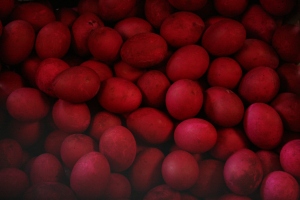Salted Egg, Itlog na Pula, Itlog na Maalat – whichever name you prefer– It is definitely one of the favorite side dishes in the Philippine table. In our home, “itlog na maalat” is served with chopped tomatoes for breakfast and “mangang hilaw” or grilled eggplant for lunch or dinner.
 There are few ways of making this salty egg. The most common (In Pateros and Victoria, Laguna) is soaking in clay. But there’s also another way — Why not Celebrate Easter by making your own “Itlog na Pula” at home ?
There are few ways of making this salty egg. The most common (In Pateros and Victoria, Laguna) is soaking in clay. But there’s also another way — Why not Celebrate Easter by making your own “Itlog na Pula” at home ?What you need….
6 c Water
12 c Salt
12 pcs Fresh Duck Eggs (you may use chicken eggs too !)
Glass Jar or Zip Lock
12 c Salt
12 pcs Fresh Duck Eggs (you may use chicken eggs too !)
Glass Jar or Zip Lock
What to do…
Boil Water and Salt. Let it cool.
Carefully place the eggs in a glass jar. Pour the water-salt solution. Make sure that the eggs are submerged. Cover the jar seal Zip lock and keep in cool and dry place for 20-25 days.
On the 26th day, transfer the salty water and eggs in a pot and boil for 10 minutes. Submerge in cold water to stop cooking.
For an authentic “Itlog na Pula”, dry and submerge boiled salted eggs in red dye
Food Notes :
1. China has nearly a thousand year history of salted egg making. And it is believed that Chinese traders brought the curing technology of making salted eggs in Philippines.
2.Salted egg is a preserved food mainly made of fresh duck eggs, containing rich nutrients such as fat, protein, various amino acids, calcium, phosphorus, iron, various trace elements and vitamins that are needed by human body.1. China has nearly a thousand year history of salted egg making. And it is believed that Chinese traders brought the curing technology of making salted eggs in Philippines.
3. Salted Eggs are not only for side dishes- it can be used as a garnish to ensaymada and other local kakanin. The distinct salty taste adds a different flavor to a dish.


No comments:
Post a Comment